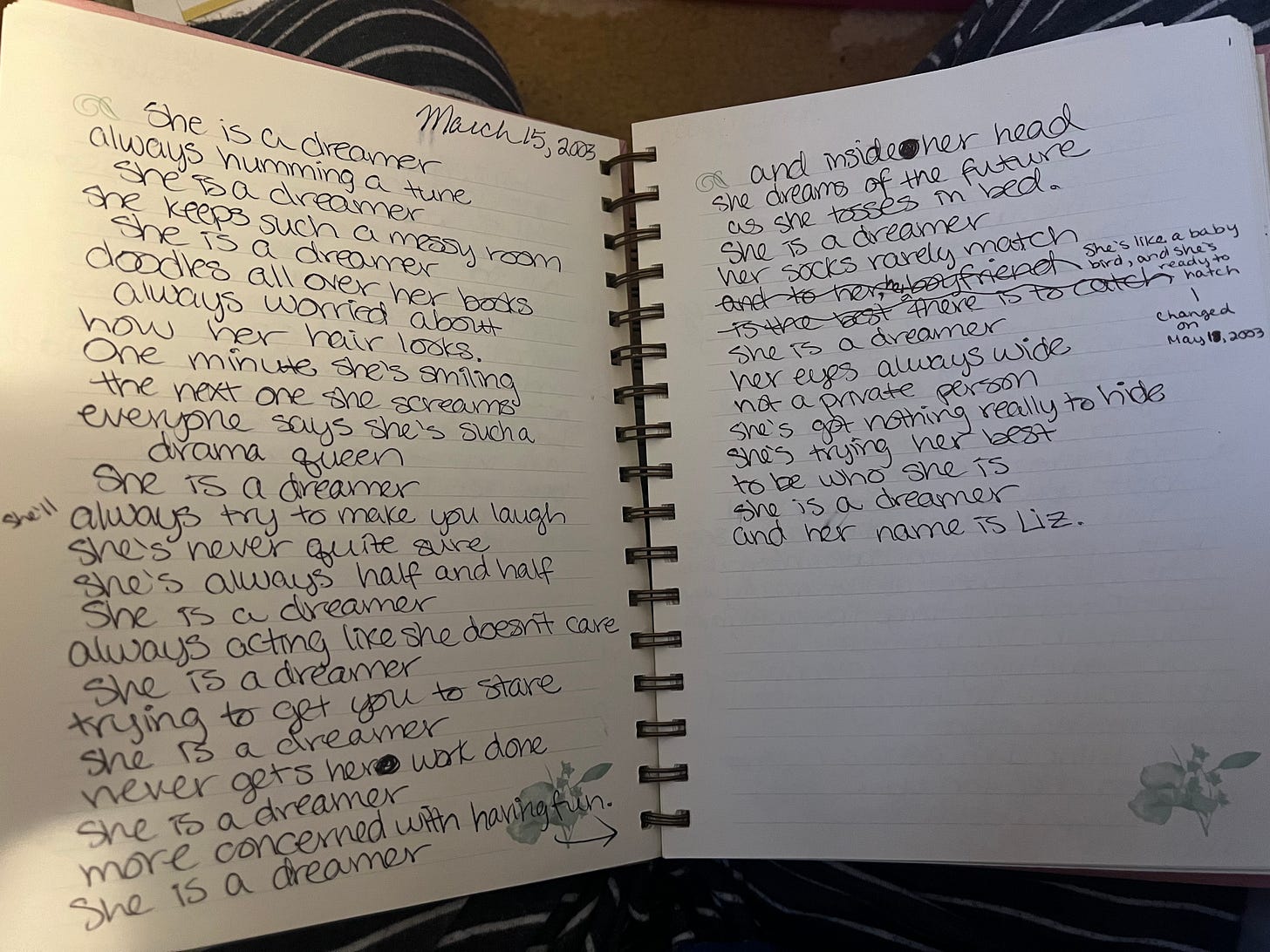ADHD and why I fell through the cracks
The role of gender differences, medical bias and societal BS in my diagnosis story
There I was, a new mom at thirty years old, staring down at my beautiful newborn as he drank from my chest, admiring the way his little hands moved while he ate. Suddenly, I felt a strain along the left side of my neck (or maybe it was the right?). “Heart attacks look different in women,” I repeated inside my head for the 100th time that week. The thought was followed by a confirming tightening of my chest and then all the air left my lungs. I stood up mid-feeding, pulling my newborn from my breast and leaving him crying in his crib. I screamed for my husband as I leaned against the wall of his nursery. My vision went black. I was certain I would never see the light of day again.
This wasn’t a heart attack. It was my body’s reaction to decades living with an undiagnosed disability. How did it get this far?
*Note: When I refer to girls and women in this entry, I’m referring to girls; women; those assigned female at birth; and anyone who identifies as female, adopts feminine social norms, or has female hormones. All of us are impacted by the lack of research in underrepresented populations.*
I always knew I was different.
I experienced the world more intensely than everyone I knew, and writing became the best way I could cope with that intensity, process it and channel it.
Recently on a particularly emotional day – those of us with ADHD have these from time to time – I found myself rooting through my old poetry searching for answers among the stream of consciousness I would release onto the pages of my journal to try to make sense of the world.
A poem I wrote at the age of 15 stunned me for two reasons:
I can’t believe how well I knew myself at such a young age
The poem so blatantly describes the ADHD experience…
How did no one see it?
Poem written in 2003, age 15
She is a dreamer Always humming a tune She is a dreamer She keeps such a messy room She is a dreamer Doodles all over her books Always worried About how her hair looks One minute she’s smiling The next one she screams Everyone says she’s such a drama queen She is a dreamer She’ll always try to make you laugh She’s never quite sure She’s always half and half She is a dreamer Always acting like she doesn’t care She is a dreamer Trying to get you to stare She is a dreamer Never gets her work done She is a dreamer More concerned with having fun She is a dreamer And inside her head She dreams of the future As she tosses in bed She is a dreamer Her socks rarely match She’s like a baby bird And she’s ready to hatch She is a dreamer Her eyes always wide Not a private person She’s got nothing really to hide She’s trying her best To be who she is… She is a dreamer And her name is Liz.
Now, dissecting the poem under the microscope of my confirmed neurodivergence, it’s easy to see elements of executive dysfunction, inattention, “stimming”, delayed sleep phase syndrome/insomnia, decision paralysis, rejection sensitive dysphoria (RSD), dopamine seeking, procrastination, emotional dysregulation, internalized hyperactivity, impulsivity and more.
But the world saw a dreamer, a drama queen, a silly… girl.
Because my ADHD symptoms could be explained away by these tropes, they went undetected. Ignored.
It would take another twenty years - two decades that included painful struggles with anxiety, depression and other comorbid conditions like the panic disorder that marked my postpartum periods - to discover the (I’ll say it) insidious reasons my ADHD was missed.
The truth is: I fell through the cracks because of the compounding impact of gender differences, medical bias, societal expectations and even deliberate decisions made in the name of “science” that left women like me out to dry.
In short, I was missed because I was a girl.
Gender differences: ADHD looks different in girls and women
When you hear ADHD… what image comes to mind? It’s a little boy bouncing off the walls, right?
While ADHD can look different in each person it appears in, and symptoms can vary by age, there are proven distinctions between how it shows up in girls/women vs. boys/men.
Women tend to have more inattentive manifestations of ADHD symptoms and less of the physical hyperactivity and impulsivity that marks the stereotypical “little boy with ADHD”. Unfortunately, it’s difficult to see what’s going on inside someone’s head, which is where inattentive symptoms occur. Girls go underdiagnosed because their most common symptoms don’t bother anyone but them.
You may have also heard the science that suggests that ADHD symptoms lessen over time, and you may have even believed, like I did at one time, the debunked myth that ADHD is only for kids. However, it is now known that while ADHD symptoms tend to minimize as boys age, ADHD in girls gets worse over time with a much later average age for onset of symptoms.
Additionally, girls/women do not show the same symptom severity (according to the diagnostic criteria *eye roll*, which we will get to later) but DO tend to have higher rates of anxiety, depression and other comorbidities. This makes our ADHD harder to spot, and many girls and women are treated for the resulting anxiety or depression, which are much more easy to identify.
We end up treating the symptoms instead of the underlying disorder.
I fully believe the anxiety I struggled with was induced by more than three decades of living with an undiagnosed disability.
The day I started medicating for ADHD, my anxiety, which at its worst had triggered panic attacks and near-constant catastrophic thoughts and required years of unsuccessful therapy, vanished. Overnight.
Medical bias: Girls and women are not studied or believed
I recently read “The Pain Gap” by Anushay Hossain, which was an incredibly eye-opening book that helped reframe so many negative healthcare experiences in my own life that I thought were my fault. Every woman (and man) should read this book. It explains so much about the lag in medical diagnoses and adequate healthcare for women, especially women of color.
Did you know that women and girls were not required to be included in medical research until the 1990s? On top of that, it wasn’t until 2016 that the government actually mandated that studies include sex as a study variable in order to receive grant money. 2016!
Did you know the results from research are STILL not required to be analyzed by that variable and in research performed by pharmaceutical companies, there is no requirement by the U.S. FDA to test their drugs or products on women before going to market with them?
Because testing on male subjects is simpler and cheaper due to hormone differences, guess who STILL gets left out of so much of the medical science we use to diagnose and treat conditions of all kinds. Women.
This problem is not unique to ADHD. Sexual bias is a problem across the board in medicine and psychology. Like so much of medical science, the research favors men and boys. In a news article published earlier this year by the Association of American Medical Colleges, it states:
Failure to study medications and other interventions in a broad sampling of women has contributed to women experiencing adverse effects from medications at twice the rate of men. One 2013 study found that women with metal hip replacements were 29% more likely than men to experience implant failure, possibly due to anatomical differences and inadequate testing in women.
Bottom line: more research in women is needed and results of existing research need to be analyzed by sex (and written into diagnostic criteria - wait for it!).
A 2018 study showed a gap in ADHD presence among men and women in the clinical population sample not present in the general population, which is a clear indicator of another kind of bias: referral bias. It showed that girls/women are less likely to get diagnoses and treatment unless they had “externalized” symptoms. In other words: male symptoms.
So many girls/women hear things like, “You can’t have ADHD, you have good grades” or “But you perform well at your job.” Clinicians ignore the debilitating symptoms that ARE present because the traditional reliance on productivity as a THE critical measure persists.
Sadly, society tends not to believe women when they voice a concern. Throughout history women’s pain and conditions have been written off as hysteria or “all in our heads”. One study showed girls have to reach a higher threshold of impairment and first had to be seen and treated for other emotional struggles and psychiatric disorders before being referred for ADHD diagnosis.
Girls simply have to jump through more hoops to prove our impairment, and when that doesn’t work, we just have to wait in torture until adulthood when it finally gets bad enough to break us.
Societal bullsh*t: Girls and women are conditioned to mask their ADHD
It wasn’t just that my ADHD was primarily inattentive that it didn’t inconvenience those around me. My ADHD didn’t bother anyone else because I was conditioned to not be a bother to anyone else. I was taught to sacrifice my own needs, ignore and bury them, and serve the needs of those around me as a duty of my sex.
Women are taught to be good, to people please, to make ourselves small, likeable, palatable and polite. We are taught our worth is tied to our usefulness to others and to our output.
In Elise Loehnen’s book On Our Best Behavior: The Seven Deadly Sins and The Price Women Pay to Be Good, she says:
“We don’t want to be perceived as wanting too much or being too much; we equate ‘self-control’ with worthiness.”
It’s no wonder so many women with ADHD struggle with self-esteem issues, depression and suicidal ideation much more than man with ADHD. We are literally wired to be unworthy by the measures we’ve been given by the world.
Girls are conditioned to mask to fit a standard, and so we do it. So, that’s what I did. In an article in ADDitude Magazine, authors Stephen Hinshaw, Ph.D., Ellen Littman, Ph.D., Andrea Chronis-Tuscano, Ph.D. summarize the harmful expectations placed on girls saying:
“There’s no room for ADHD when society expects girls and women to be perfect — nurturing, competitive, and sexualized — a pernicious triple bind accentuated during adolescence.”
Many girls, like me, grow up to become workaholics and perfectionists, obsessed with achieving to prove themselves and mask even further. It’s an unsustainable pattern that eventually leads to intense burnout.
Luckily (I guess?), the societal expectations of women and mothers are so impossibly high, they became the very catalyst – in trying to keep up with them – that made me seek my diagnosis. They became the impetus for me to begin the process of chiseling myself out of the iron mask I’d created in order to feel worthy.
Purposefully leaving women out: The current diagnostic criteria is lazy science
ADDitude magazine recently launched a campaign to bring the issue of women with ADHD to the forefront of the collective conversation. I learned in doing some of my own research that “THEY”, the all-powerful owners of the diagnostic criteria written into the DSM-5, have fully known that the symptoms of girls and women were left out of the science… left out of their criteria - and it’s not because of some oversight.
They have purposefully excluded emotional dysregulation, one of the most prominent symptoms of ADHD in all people, but especially women, and executive dysfunction – which, come on! ADHD is executive dysfunction.
The choice was made because it wasn’t scientifically clean - meaning some of these symptoms show up in other conditions. It could muddy the waters. There’s variability that some scientists don’t feel comfortable with.
They feared including these common symptoms would significantly increase the amount of ADHD diagnoses, so they chose not to include the science that was staring them in the face.
This decision egregiously resembles the same argument for leaving women out of medical research altogether. It’s the same reason we are so often overlooked. We have too much hormonal variability to be studied. We’re too nuanced. Too complex, and therefore, undefinable.
I know this isn’t exactly my area of expertise (I realize I’m a journalist not a psychiatrist), but I do know the answer simply cannot continue being that it’s just too difficult to diagnose some women with ADHD. I think this is lazy science with harmful, even deadly consequences.

The seriousness of this issue: Diagnosis is often a matter of life and death
Research shows that the effects of delayed diagnosis and treatment in women are vast and all-encompassing and may include: academic and social problems; increased anxiety; anger-management issues; mental health problems requiring treatment; difficulties coping with home life; physical symptoms like sleep problems, headaches and stomach issues; eating disorders; workplace performance issues; propensity to self-medicate with drugs and alcohol; and higher likelihood to find themselves a victim of a driving accident, partner violence or sexual abuse.
And it isn’t just a quality-of-life issue, very often it’s a matter of life and death.
Importantly, young girls and women with undiagnosed and unmanaged ADHD are more likely to engage in self-harm or even suicide. This problem couldn’t be any more serious.
Diagnosis is not only life changing for so many… it’s life saving.
Pulling directly from a National Library of Medicine journal article called Miss. Diagnosis: A Systematic Review of ADHD in Adult Women, without diagnosis:
“…women with ADHD often report spending their lives feeling “different,” “stupid,” or “lazy” and blaming themselves for their underachievement (Lynn, 2019). Consequently, receiving a diagnosis of ADHD can be instrumental for a woman’s self-esteem and identity (Waite, 2010). Many women experience diagnosis as a lightbulb moment, giving an external explanation for their struggles and allowing them to accept themselves more fully (Stenner et al., 2019).”
Diagnosis alone doesn’t solve all our struggles, but it helps provide context for them. It gives us a chance to accept ourselves (and to seek treatment and other necessary accommodations). At the very least, we deserve that.
Here for the dreamers: Why I won’t stop advocating
I think about my postpartum self and want to tell her everything I know now. I want to tell her there’s nothing wrong with her. That her body is naturally reacting to the lack of support she so desperately needs and deserves.
I think about my 15-year-old self, the dreamer, and how she wanted so badly to take on the world. I think about how she pushed herself to compete in a world not designed for her special brain.
I grieve for them both.
While we are making progress in awareness, action is lagging. There’s still glaring holes in the DSM-5 that “THEY” keep promising will be updated soon. Changes are happening too slowly and don’t go far enough to help all the little girls out there who know they’re different and deserve to know why.
This week, I will attend my daughter’s preschool graduation. I will watch her perform songs, recite rhymes, and gleefully grasp her diploma along with all the hope and confidence in the world for what she can achieve. I won’t stop advocating until I know that she’ll be taken care of… until her joy and confidence are no longer threatened by looming injustices.
In honor of Mental Health Awareness Month, I share my story to continue raising critical awareness of these issues and to help push for a better future. I share my story for the dreamers, the drama queens and the silly girls who deserve a happy, more carefree life…understanding their special brains and feeling comfortable in their own skin.
***I’ve linked to a ton of helpful resources on this topic throughout this entry all of which confirm the same thing: that there’s a definite and insidious lack of support for ADHD diagnosis in women. If you read only one resource: make it this one, which provides useful suggestions for clinicians and researchers - but also for parents, teachers and self-advocates - to be aware of the barriers for diagnosis for girls/women and to help break them down.***
I won’t stop advocating for our special-brained little dreamers.








